How to Resolve the Surprising Cane Corso Vs German Shepherd Dog Dilemma
Are you experiencing that extraordinary and fleeting time in your life where choosing your next dog is your biggest worry? What breed should you consider?
If you are pondering the virtues of a German Shepherd, you will be in good company – they are hanging on to the #2 spot on the AKC most popular dog rankings as of 2017.
Maybe you are torn between a Cane Corso vs German Shepherd.
German Shepherds are slightly more intelligent, more trainable, more of a one-person dog, more protective, more weather-adaptable, and less susceptible to prejudice by insurance companies.
Cane Corsos are easier to groom, require a little less exercise, are more outgoing with strangers, more water-loving, and more intimidating.
Read on to learn all about the differences and similarities between German Shepherds and Cane Corsos!
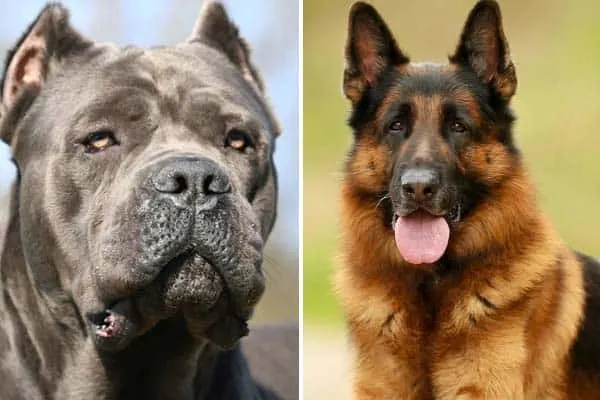
What are their breed histories?
A dog’s background says a lot about how it looks and behaves and what type of work it may be suited for.
Cane Corso
Cane Corsos were warriors of the Roman Empire who descended from Italian and Greek Molossian dogs that also gave rise to the Neopolitan Mastiff.
While fighting is likely part of their backgrounds, Italian Corsos were primarily bred to fight in wars and to guard farms and families.
However, the Romans also enjoyed dog fights as well as watching canines engage with bulls, bears, and lions.
Cane Corsos also found use on farms herding cattle and protecting livestock from predators and thieves.
Later, Cane Corsos were developed to hunt large game like boars and specialized prey like porcupines.
Greyhound is thought to have been infused to obtain more agility and speed and to improve the Cane Corso’s ability to grasp, instead of just crush, prey.
It contributes to their skills as coursing mastiffs, able to chase down prey primarily by sight.
According to Dicasamarziali, Boxers were introduced to the bloodline later to refine the Cane Corso’s size, increase tractability, and introduce the sought-after undershot jaw.
A scissor bite is still desired in show Cane Corsos, although a slight underbite is acceptable.
German Shepherd
The German Shepherd was developed by Captain Max von Stephanitz among others into its modern form from ancestral herding dogs of Central and North Germany.
Originally bred to herd sheep, the German Shepherd’s versatility seems boundless.
Von Stephanitz’s visionary work prepared the German Shepherd for a career beyond sheep herding, which was in rapid decline.
He also avoided introducing extreme characteristics that other breeds were subjected to.
German Shepherd’s emphasis historically was largely on the dog’s mentality. Dogs that did not meet stringent physical and mental criteria were excluded from the breeding program.
From 1899, dogs were selected for their beauty, strength, tenacity, and intelligence to lay the groundwork for the ideal working dog, the German Shepherd.
The ancestral German Shepherd lines involved extensive inbreeding along with a few wolf outcrosses.
Unlike many dog breeds, there is a marked distinction between the sexes.
The German Shepherd breed standard even remarks on the requirements for noticeably feminine and masculine-appearing dogs.
German Shepherds proved their indispensability to German soldiers in World War I.
Harrison Eustis in Switzerland used a scientific approach to breed the best German Shepherds and her dogs became foundation stock for many seeing-eye canines.
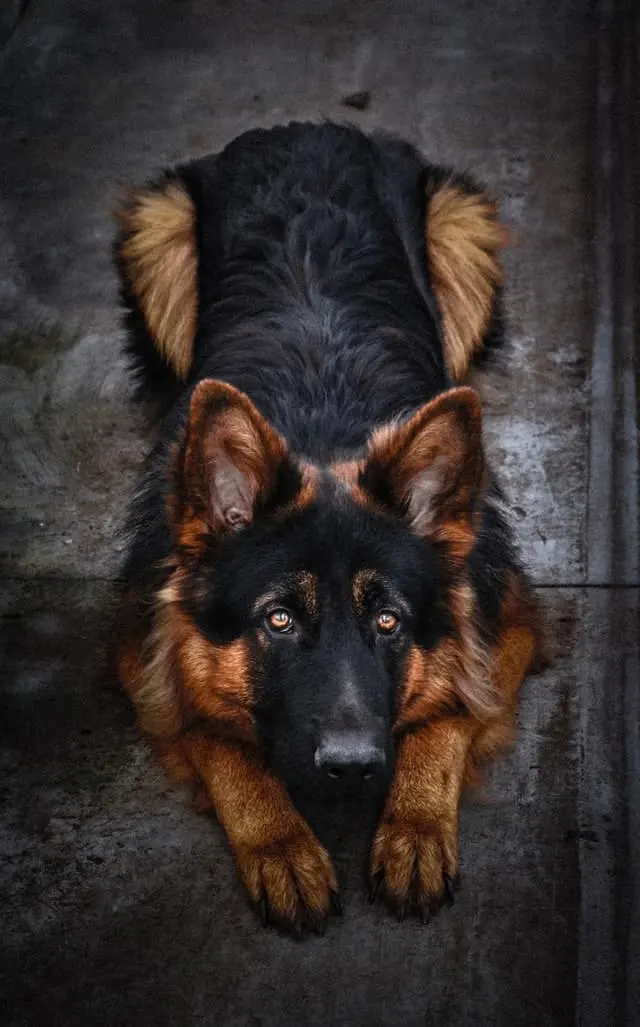
How large are they?
If you have narrowed your choices to the Cane Corso and German Shepherd, then clearly you want a large dog. Both breeds are not only large in stature but imposing in their presence and intimidating.
All heights on dogs refer to how tall they are at the top of their shoulders.
Cane Corso
Cane Corso Italianos are in the mastiff family and their size reflects it. Females are 23 to 25 inches tall while males average two inches taller.
A Cane Corso will weigh between 80 and 120 pounds. Males are approximately 15 to 20 percent heavier than females.
German Shepherds
German Shepherds are slightly shorter than Cane Corsos and significantly lighter.
They range from 22 to 26 inches tall and weigh between 60 and 75 pounds, although some American breeders aim for massive dogs that are up to 125 pounds.
What kind of temperament will you see?
When comparing temperaments between dogs like Cane Corsos and German Shepherds, you are likely most interested in suitability as a guard and family dog. Are these breeds dangerous?
Cane Corsos and German Shepherds are similar in their ability to bond with family members and their natural protectiveness. Both are suitable for children within the family if raised properly.
No matter how docile and loving your dog is, we recommend never leaving your Corso or Shepherd with a small child unsupervised.
No dog should be alone with young ones, but large breeds require additional precautions.
If there is a disagreement between your canine and child, you cannot rely on your dog to realize its strength or recognize the permanent results of its actions.
Likewise, you cannot depend on your toddler to read danger in your pet’s body language.
Cane Corso
Look for confidence and even assertiveness in a Cane Corso. Like other mastiffs, Cane Corsos can be strong-willed and bull-headed.
However, they are more cooperative and attentive than other mastiffs, and many consider them much easier to train.
Nevertheless, they tend towards dominance aggression, requiring a self-assured owner who will command their respect.
Owners also need to exercise consistency and authority in their training methods to ensure a family-oriented companion fit to be around small children.
In the wrong hands, Cane Corsos are dangerous like any other breed. Particularly worrisome is their massive size. Poor breeding tends to promote overly aggressive behavior in individual dogs.
Improper socialization may lead to a dog that attacks unprovoked or a pet who is skittish and bites from fear.
A well-bred and well-trained Cane Corso should be alert but calm around strangers. The Cane Corso has a no-nonsense demeanor which is usually threatening enough without the need to attack.
Corsos are loyal and affectionate, bonding strongly with their families. They become destructive when left to their own devices too long or if they become bored.
They possess an instinct to protect their owners and family.
German Shepherds
German Shepherds are loyal, courageous, intelligent, and intense. Their abilities to focus on the task at hand stem from their herding backgrounds.
They are highly trainable and obedient but require mental challenges to keep them happy and cooperative.
German Shepherds have more of a tendency to bond with one family member than do Cane Corsos. Poor breeding can produce dogs that are shy and cower or fear-bite.
You could also obtain a dog that is excessively suspicious of strangers, threatening, or even attacking them.
If you have raised your GSD in a properly socialized environment, it should be distantly polite to indifferent to your visitors.
The German Shepherd is another breed that is instinctively protective of property and family, not requiring much formal guard training.
German Shepherds with consistent training are good with children. Some even learn how to be gentle around infants.
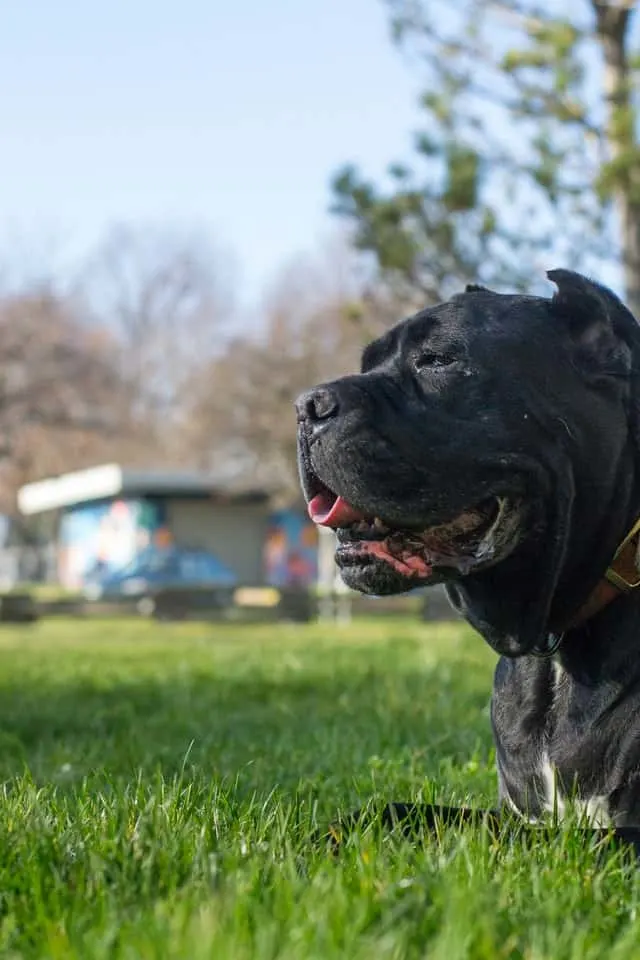
What are their exercise requirements?
Cane Corsos and German Shepherds have similar space requirements and near-identical exercise needs.
German Shepherds are moderately more energetic and have more stamina than Corsos. Both breeds require 45 to 75 minutes of exercise daily.
What is the cost of a German Shepherd vs a Cane Corso?
The purchase price varies considerably between the two breeds as pets. Show and performance animals are very similar in price.
Maintenance costs are similar at all levels with veterinary expenses, health maintenance, food, bedding, fencing, training, and grooming.
Notable exceptions are ongoing training for working dogs and grooming for show Shepherds.
Your purchase price of a puppy should include initial vaccinations, physical exams with certificates of basic health, and parasite control.
Sometimes, the price also includes neutering and certificates against breed-specific health issues.
For example, if you buy a breed prone to hip problems, the breeder may send the hip certifications of the parents with your puppy.
When you make your final selection of a puppy, account for shipping costs if applicable. These can range from fifty cents to over a dollar a mile.
German Shepherds
Rescue dogs can cost between $75 and $350. You can buy a German Shepherd pup from a reputable breeder for $300 to $1000, although those at the lower end may not have papers proving their pedigree.
Working dogs cost $1000 to $3000 while show dogs are between $2500 and $5500. According to howmuchisit.org, fully-trained working Alsatians can cost over $10,000.
Most of them have hips that have been certified “Good” or better by the Orthopedic Foundation for Animals.
Cane Corsos
Puppy ads vary wildly in prices, quoting $700 to over $3000 for a Cane Corso. The median price, according to mydogsname.com, is around $1100.
Potential breeding stock pups can be as much as $3500 and show-quality adults $8500. Rescue dogs may be under $500.
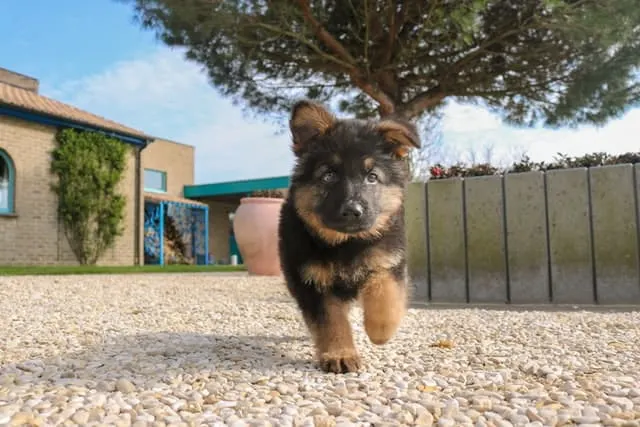
How is their health?
Both the German Shepherd and Cane Corso have a life expectancy of about 10 to 12 years. They have heritable problems like most purebred dogs, some of which are related to their size.
Dysplasia
A Corso and Shepherd’s orthopedic problems include hip and elbow dysplasia.
Idiopathic Epilepsy
Seizures with an unknown cause occur and are believed to be hereditary.
Gastric Dilatation and Volvulus
Because they are deep-chested, Cane Corsos and German Shepherds are at particular risk for a condition called bloat. It is distension of the stomach from excessive gas build-up.
It is always an emergency because the stomach can rotate.
According to PetMD, Take a few steps in prevention is key and quite simple. Allow two hours between a meal and exercise.
You should feed large dogs a few meals throughout the day rather than one or two large ones. Do not elevate your dog’s food or water.
What problems are specific to Corsos and not Shepherds?
- Eyelid abnormalities – lids roll inward in entropion or droop outward in ectropion
- Cherry eye – a gland in the third eyelid prolapses
- Demodex – a type of mange caused by certain mites that proliferate in the skin when the immune system is compromised.
What health issues are common in Shepherds and not necessarily in Corsos?
- Degenerative myelopathy – progressive neural disease autoimmune based
- Perianal fistulas – infected draining tracts
- von Willebrand’s – a clotting disorder
- Cryptorchidism – one or both testicles do not descend
- Eye problems – retinal atrophy and Pannus
Do they get along with other dogs?
Cane Corsos
Although Cane Corsos were not bred for dogfighting, there is little doubt they had to scrap for survival in ancient Roman times.
Cane Corsos occasionally show aggression towards other dogs, especially against the same gender.
Many Cane Corsos are amenable to other dogs equal to their size.
Cane Corsos have a strong prey drive and should not be completely trusted with small animals.
German Shepherds
German Shepherds are generally social and polite with other animals. They rarely show disproportionate aggression to other dogs. When properly socialized they play well with others.
Whether you argue that herding is a form of prey drive or that herding dogs develop chasing from bad habits, German Shepherds should be managed with caution around small animals.
How are they in weather extremes?
Their large sizes make Cane Corsos and German Shepherds more tolerant of heat and cold than smaller breeds.
The German Shepherd’s dense undercoat makes it comfortable in frigid temperatures and protects it from ultraviolet light.
The Cane Corso is more sensitive to extreme cold with its shorter coat. It is also more vulnerable to the heat because of its shortened nasal passages.
Cane Corsos are not particularly susceptible to heatstroke, however, like Bulldogs and Boxers.
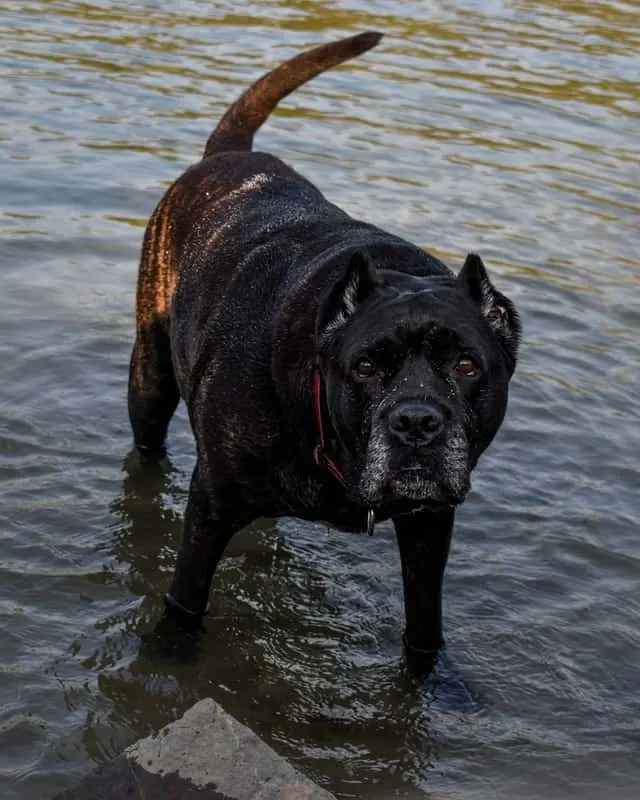
What activities are they suited to?
Both the Cane Corso and German Shepherd are versatile working dogs that have a history in the military and on farms.
Cane Corsos
Cane Corsos maintain some of their historical duties today, guarding families and their belongings, livestock such as swine, cattle, and poultry, and hunting.
They are used in police work but may also engage productively in leisure activities.
- Pulling competitions
- Agility
- Hiking
- Dock diving
German Shepherd
German Shepherds are among the most versatile working dogs.
Their exceptional intelligence, athleticism, loyalty, and ability to remain single-minded make them widely employed in the police force for drug and search and rescue.
They are one of the few breeds commonly enlisted to serve the blind. They are one of the most commonly used guard dogs.
German Shepherds remain widely popular because their versatility and excellence extend to common amusements.
- Agility
- Swimming
- Herding trials
- Tracking
- Schutzhund training
What are the grooming requirements?
Grooming needs are one of the greater distinctions between the two breeds. Both dogs require occasional baths, regular brushing, and consistent toenail trims. Neither needs coat clipping.
Cane Corsos
Cane Corsos are straightforward to groom. If their ears are not cropped, you need to dedicate more attention to cleaning them to prevent yeast and bacterial infections.
Cane Corsos need regular brushing of their short fur to free it of dead skin, debris, and loose hair and stimulate circulation. They usually enjoy the water, so occasional baths should be easy.
German Shepherds
German Shepherds usually have medium length fur, although some have longer hair than others. Their fur is not prone to matting except occasionally on the backs of their upper hind legs and their tails.
Ideally, you should brush your Shepherd daily to remove clumps of dead undercoat hairs and built-up dirt. You should brush thoroughly every three weeks.
Although German Shepherds do not blow their coats like huskies, they will experience increased shedding at the seasonal changes. These are often good opportunities to bathe them.
German Shepherds often have sensitive skin and usually, it is best to be safe with a gentle shampoo such as a lavender-based shampoo with soothing properties.

Are there any liabilities to owning a Cane Corso or a German Shepherd?
Navigating the adventurous path of dog ownership is tricky in an age when pet owners are held more accountable than ever for damages and injuries their four-legged companions may cause.
According to PsychologyToday, Many insurance companies have even gone as far has to refuse certain dogs based on breed alone.
Owners of rental properties have followed suit in many cases.
Since some bans are arbitrary and others are not, it pays to check that your new addition will have a place to live if it is a Cane Corso or a German Shepherd.
Cane Corsos
Cane Corsos are listed in the top 10 on many lists of most dangerous dogs. Lumped with Mastiffs and Bully dogs, they are likely to also be on many apartments and rental home blacklists.
This is a serious consideration if you are thinking about owning a Cane Corso.
Insurance companies seek to protect themselves not because they think Cane Corsos are inherently evil but because of the potential damages.
An insurer’s costs to fulfill such claims from a dog attack could be catastrophic.
German Shepherd
If you think you will simply avoid liability issues by choosing a German Shepherd Dog, reconsider.
The trend is heading toward banning all large guard dogs like Dobermans and German Shepherds.
In fact, according to Property Casual 360, German Shepherds are more likely to appear on an insurance company banned dogs list than Cane Corsos.
What do they look like?
We saved this for last because Cane Corsos and German Shepherds are so similar in their other qualities you will probably base much of your decision on appearance.
Cane Corso
The Cane Corso is not the largest mastiff-type by far, but still gives the impression of power while at the same time moving with grace.
The breed standard calls for a medium-large, sturdy, large-boned, and balanced dog.
A Cane Coro’s head has Molossus Dog traits, large and twice as wide as it is long. Its ears are naturally folded but often cropped.
Their muzzles are very broad and somewhat shortened.
Cane Corsos have heavily muscled bodies evident through the hindquarters and the shoulders. Although wide-based, they do not have the bowed legs you see in other mastiffs or bulldogs.
Cane Corsos have short stiff outer guard hairs over a light undercoat. Their coat is somewhat rough and waterproof. Corsos can be fawn, red, black, or varying shades of gray which may look bluish.
They have minimal white, and red or fawn dogs may sport black or gray facial masks. Their eyes complement their coat colors, ranging from dark brown to amber to aqua-green.
Blue eyes are a fault that is disqualified in the show ring.
Black and tan dogs occur but the color is considered unacceptable.
Like others in the group, Cane Corsos have thick muscular tails set low and often carried level with their backs with a slight curve towards the tip.
German Shepherds
The German Shepherd should strike you with an intelligent, elegant, and athletic bearing. Unlike the Cane Corso, the Shepherd is wolf-like in appearance.
It is more rectangular and lithe but still maintains balance and is well-muscled.
German Shepherds have chiseled and domed heads, neither fine like a Greyhound’s nor coarse like a terrier’s.
They carry their large moderately pointed ears erect, although pups may have endearingly floppy ears. The muzzle is long and square to wedge-shaped.
In the body, the German Shepherd should lack bulk and have a characteristic slope from its shoulders to the back, which should be straight.
Note that some show circles propagate an exaggerated slope in the Shepherd’s, back which adversely affects its confirmation and mobility in the hindquarters.
German Shepherds have a wavy to straight outer coat with a dense undercoat. Their hair is shorter on their faces and legs and longer along their necks.
You probably think of a German Shepherd as a black and tan or solid black dog, but they can be various colors including gray, red and black, and sable.
Dilute colors and liver and blue are not accepted by the AKC. White is also considered grounds for disqualification, although some people actively seek white German Shepherds.
Unlike wolves or huskies, German Shepherds have long and bushy tails that do not curve over their backs.
Read Next: Can You Really Know What You Get in a Rare German Corso?






























